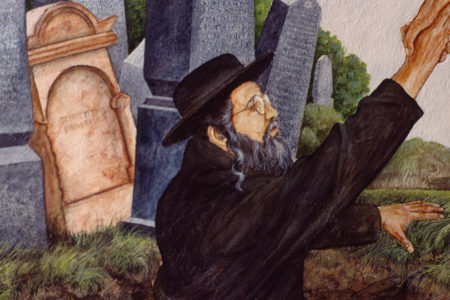An Uneasy Tension
The Early History of Jews and Christians
Relationships between Jews and Christians have always been characterized by an uneasy tension, which has at times turned into violence of the worst kind. At other times, relations between the two have been more peaceful, but there has always been a recognition of the differences, as well as the similarities, between these two faiths that command the allegiance of over one-fourth of the world’s population.
It is common knowledge that the early movement that eventually became known as Christianity began as a sect within the Jewish community. Jesus was born of Jewish parentage and was raised in a Jewish town and a Jewish culture. All of the early disciples were Jews. During the first few decades of its existence, the church was predominantly Jewish. During those early days, tensions between the two communities began to manifest themselves.
In the early chapters of Acts, the Jewish religious leaders strongly opposed the preaching of the apostles. Because they preached the resurrection of Jesus, they were arrested and interrogated by the Sanhedrin (Acts 4:1–22). Later they were arrested, thrown in prison, and tried again before the same Sanhedrin (Acts 5:17–32). Only the tolerant counsel of die wise Gamaliel prevented their being killed then and there (Acts 5:34–40). In spite of this intervention, however, serious persecutions against the Nazarenes continued to take place. One of the ringleaders of this persecution movement was a young rabbi named Saul (Acts 8:1–3), whose ham-filled career was soon radically altered by the very one whom he hated (Acts 9:1–9). When Herod Agrippa I, the grandson of Herod the Great, came to power in Judea, he wanted to please the Jewish religious establishment. He did so by killing the apostle James and imprisoning Peter (Acts 12:1–4). In spite of all this opposition, the good news of Jesus’ resurrection continued to spread, even beyond the Jewish communities to the Gentiles (Acts 11:19–20).
When Paul began to take the message of Jesus into the lands of the Diaspora (the Jewish dispersion), he always ministered first to his own Jewish people (cp. Acts 13:5, 14; 14:1; 16:13; 17:2). The Jewish opposition, however, continued unabated, sometimes threatening his very life. At Lystra, Jews from Antioch and Iconium stirred up the people, who stoned Paul and left him for dead (Acts 14:19). In Thessalonica, the Jewish leaders incited a riot and sought to apprehend Paul, but they failed (Acts 17:59). When Paul visited Jerusalem, the rumor spread that he had brought a Greek into the Temple, and a crowd almost lynched him (Acts 21:27–31). None of this opposition embittered the apostles, however. Right to the end of the Book of Acts, it is recorded that he continued to reach out to his brethren in the flesh (cp. Acts 28:17–29). He expressed his love in these notable words: “Brethren, my heart’s desire and prayer to God for Israel is, that they might be saved. For I bear them witness that they have a zeal for God, but not according to knowledge” (Rom. 10:1–2).
As stated earlier, during the first few decades of its history, the Church was composed predominantly of Jewish people. It was not until after the destruction of Jerusalem and the Temple in 70 A.D. that Gentiles began to comprise the majority of believers. The churches in the land of Israel, however, continued to be primarily Jewish. Records indicate that the church in Jerusalem continued to have Hebrew-Christian pastors or bishops for at least a hundred years following Jesus’ death and resurrection. During this transition period, some Jewish believers continued to visit the synagogues on occasion, and the problem of their legal status perplexed the rabbis after the destruction of the Temple.
After AD 70, the Sanhedrin reorganized itself in the coastal town of Yavneh, below present-day Tel Aviv. There, during the next 30 years, the rabbis decided many important matters, including the final listing of the Old Testament canonical books. One of the problems they dealt with was what to do about Jews who believed that Jesus was the Messiah. Around AD 90, a petition was introduced into the daily liturgy of the synagogue that was intended to single out any Nazarenes who might be present. This petition requested that “the Nazarenes and the heretics perish as in a moment and be blotted out from the book of life, and with the righteous may they not be inscribed.” Obviously, a Nazarene (a Jewish believer in Jesus) could not pray this curse on his own head. Thus, it became impossible for them to remain in the synagogue. The inevitable parting of the ways had taken place. From that time to the present, the official position of Judaism has been that Hebrew Christians are not welcome as synagogue participants. Although they are still considered to be Jewish, they are now thought of as heretics. Some modern Jewish believers, who style themselves as the fourth branch of Judaism, must recognize this historical fact. Although the two faiths share a common heritage, they have irreconcilable differences in regard to the Messiah, the nature of God, and the nature of redemption.
For more than 60 years after the Temple’s destruction, Jews and Nazarenes continued to live side by side in the same communities, although they worshipped in different ways. The final breach came during the Second Jewish Rebellion against Rome from AD 132 to 135. During this war, the great Rabbi Akiba proclaimed that the Jewish general, Ben Koseba, was the Messiah. Akiba named him “Bar Kochba” (son of the star), a reference to Balaam’s prophecy in Numbers 24:17. The Jewish Christians living in Israel obviously could not follow this false messiah because they believed that the Messiah had already come. For their refusal to participate, they were castigated by the Jewish community. Whereas they had been expelled from the Jewish synagogues a few decades before, now they were expelled from the Jewish communities. It was during these troubled days that the term meshumed, meaning destroyer or apostate, was applied to the Jewish Christian.
Although records indicated that during the early days of the church it was often the Jewish leaders who persecuted the believers, that situation eventually changed drastically. As a matter of fact, the persecuted actually became the persecutor!
Christian Imperialism
As noted above, for the first 200 years of church history, relationships between Christians and their Jewish neighbors were best characterized by the phrase an uneasy tension. During that period, there was no evidence of outright Christian persecution of the Jews, but the Jewish leadership sought to repress the Nazarenes and eventually expelled them from the Jewish community.
Undoubtedly, there were many opportunities for dialogue and witness between Jews and Christians during the first two centuries of our era. One classic confrontation is recorded in the book Dialogue with Trypho the Jew, written by Justin Martyr, one of the church fathers, around AD 140. It records a series of lengthy conversations between Justin (a Gentile believer later martyred in Rome) and Trypho, a Jewish rabbi from Judea. Justin appealed to the fulfillment of many Old Testament prophecies by Jesus as evidence that He was the promised Messiah. Trypho responded to his witness with many of the standard Jewish responses. In the end, Trypho did not receive Jesus as his Messiah. The exchange, however, was marked by respect for each other, and the two parted as friends. We have no reason to doubt that this exchange was probably characteristic of the witness and dialogue that prevailed between Jews and Christians for nearly 300 years.
Jewish-Christian relationships underwent a complete turnaround, however, in the fourth century AD. The persecuted actually became the persecutor. When the Emperor Constantine dedicated himself to be a Christian, he began to favor the previously persecuted church and suppress paganism and Judaism. Although Judaism had previously enjoyed a legal religion status, when Christianity became the official religion of the Empire, the Jews began to suffer severe remission of their rights. It has often been said that the worst event to happen to the church was the conversion of the Emperor Constantine. The church gained temporal power while losing its spiritual power.
In AD 315, Constantine forbade Jews to make proselytes, thus denying Judaism the opportunity of being a missionary religion. In AD 439, Jews were denied the privilege of holding public offices and were not permitted to construct new synagogues (repair of old ones was permitted). In AD 531, the Emperor Justinian forbade Jews to testify in court against orthodox Christians. These discriminatory laws entrenched the second-class status of the Jewish people and set the stage for the miserable events of Jewish existence in the Middle Ages.
The sad thing is that these and other secular laws were religiously motivated. The influence of theologians on treatment of the Jews can best be illustrated by summarizing the basic theological position of the Jews in the succeeding years. According to this view, the Jewish people were condemned to eternal servitude for the crucifixion of Jesus. They were not to be killed, however, but were to be preserved in a life worse than death. A remnant was to be scattered and through their Scriptures, as well as through their bodily existence, they were to serve as eternal witnesses to Christendom, that the prophecies concerning Christ were true. Until the last judgment, they were to remain in servitude, inferior to all Christians.
Two points should be noted about this theological anti-Semitism, which has prevailed in many circles of church history down to the present day. First, this so called theology is not found in the New Testament. This often comes as a surprise to Jewish people, who assume that the Gentile book, about which they have been warned, does not present the Jewish-people in such a way. Second this replacement theology can be traced to Augustine and some other early church fathers, whose theological system had no place for the Jews. Today their system is known as covenant theology and is sometimes referred to as amillennialism. This system teaches that all of the promises to Israel have been inherited by the church; Christ is presently reigning as King; and we have been in the Millennial Kingdom since the first advent. Therefore, no distinct role exists for the Jewish people in God’s plan. Other articles in this issue trace how this theological anti-Semitism, which developed in the fourth and fifth centuries, manifested itself in some inhumane and un-Christian ways.
The lesson we must learn from this brief overview is that whenever temporal power marks the church, it loses its spiritual power. Only when we possess the love of Jesus and Paul for their own brethren are we able to relate to unbelieving Israel with a winsome witness.








